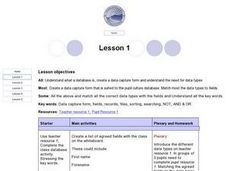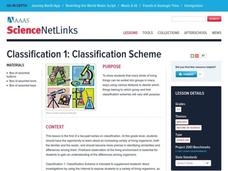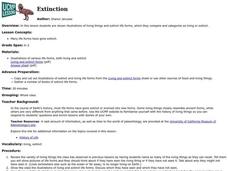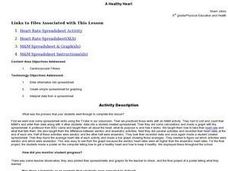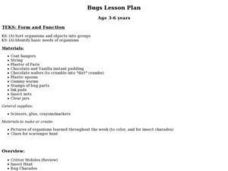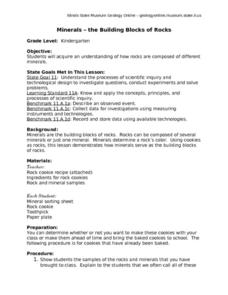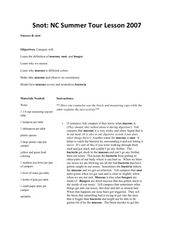Curated OER
Living or Nonliving
Third graders brainstorm a list of the characteristics of living and nonliving organisms. Individually, they find four nonliving and living items and the characteristics that make them fit into one of the categories. To end the...
Curated OER
Liquids in Bottles
Students investigate different liquids to develop their concept of a liquid. They work at a center to tip, swirl, shake, roll, and otherwise investigate seven liquids in small, clear plastic bottles: plain water, corn syrup, liquid...
Curated OER
Rock Cycle SIOP Unit
Young scholars collect rocks, identify them, classify them, investigate their properties, and more. In this rocks lesson plan, students also experiment with soil and erosion and weather.
Curated OER
Scavenging the Sandy Shore
Students explore oceanography by examining a beach. For this living things lesson, students define the terms abiotic and biotic and practice identifying living and non-living things that have been previously found on a beach. Students...
Curated OER
Waddle You Know About Penguins
Second graders study the similarities and differences of the seventeen species of penguins. They investigate habitats and how these habitats are suited to each species characteristics. They see how animals adapt to their environments.
Curated OER
Amazon Rainforest
Seventh graders complete a simulation in which they travel through the Amazon rainforest. Using their map skills, they determine the best route and where to see specific plants and animals. They develop their own database to organize...
Curated OER
Sink or Float?
Students examine how weight and balance can effect if an item sinks or floats. They listen to the book "Who Sank the Boat?" by Pamela Allen, and discuss how the smallest animal sank the boat. Students then conduct an experiment in...
Curated OER
Testing Battery Combinations
Fourth graders examine the required combinations of plates and predict which combination will generate the most and least current and voltage. They use an ammeter and experiment with combinations of their own testing and record each...
Curated OER
Some of Its Parts
Young scholars study a can opener to find the important parts that make it possible to take the lid off a can of food. They then use this information to decide what new or different subsystems could be added to make it better and...
Curated OER
Database
Second graders collect daily weather information and introduce them to databases.
Curated OER
Classification and Attributes
Students classify objects based on their attributes. They explain how archaeologists use classification to help answer research questions.
Curated OER
Dinosaurs
Students study the lives of dinosaurs. In this dinosaur lesson plan, students create dinosaur dioramas that depict how and where the creatures lived. Students also discuss extinction with their teacher.
Curated OER
Adaptations
Young scholars identify what adaptation is and to research a specific mollusk. They also identify and interpret how animals get their common and scientific name and why it is Latin. Finally, students draw their shell (mollusk) and name...
Curated OER
Planets
First graders study the planets in the solar system. In this planets lesson, 1st graders read Planets, then create a mobile containing all of the planets in the correct order. Students will label the planets with descriptive words.
Curated OER
Extinction
Students peruse illustrations of living things and extinct life forms, which they compare and categorize as living or extinct.
Curated OER
HOW FAST DO SEDIMENT GRAINS OF DIFFERENT SIZES SETTLE?
Students conduct an experiment using sand, a jar, and a paper clip to analyze the effects of different kinds of sand vis a vis its sediment. They graph their findings and analyze for factors of size, shape, and density.
Curated OER
A Healthy Heart
Sixth graders create a spreadsheet using specific data. A speaker comes to discuss the heart, and the difference between anaerobic and aerobic activity. They make posters to encourage a healthy heart lifestyle.
Curated OER
Bugs Lesson Plan
Students complete a unit of lessons on insects. They participate in a bug hunt, construct paper flowers, discuss pollination, create bug paperweights and insect mobiles, play bug charades, and participate in a bug scavenger hunt.
Curated OER
Minerals- the Building Blocks of Rocks
Students investigate how rocks are composed minerals by dissecting rock cookies.
Curated OER
The Value of Behavioral Variation in Homo sapiens
Students look at the behavioral characteristics of their peers from a historical perspective, and realize that, in the larger scheme of a community, these behaviors do have some value, and that a society as complex as ours does need the...
Curated OER
Relationships, Rules, and Responsibilities
First graders identify jobs in the environment. In this social justice lesson, 1st graders describe rules to protect the environment and the roles specific jobs play. Students construct environmental rules for an imaginary town.
Curated OER
Snot: NC Summer Tour Lesson 2007
Students study various aspects of mucous. In this mucous lesson, students investigate the purpose of mucous. Students create fake mucous.
Curated OER
Summer Scientists
In this lesson plan, students discuss and reocrd what makes an object living or nonliving. The students then chart the lists of living and nonliving objects. Teacher allows students oportunity to go outside and look for living and...









